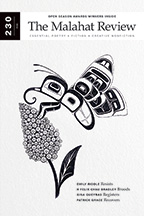excerpt from "Little Beauty"
by Alana Friend Lettner
It’s a blasted, lonely, silent place, the clearcut in early spring. On a drab urban day when greyness reigns on vertical and horizontal planes—grey sky and grey pavement conspiring to dampen the spirit—I like to go there. I go there not in body but in mind, by way of imagination; the clearcuts I know best are near Burns Lake, British Columbia, some 1,000 kilometres away from where I live on Vancouver Island. In my mind I’m working in the land and it’s early May, barely spring there. The sky is high and blue, with massive clouds moving overhead spurred on by a leftover winter wind. It’s the perfect weather for tree planting: cool and a little cloudy. The earth is still thawing from months of winter, and from time to time I throw my shovel and open a hole not of soil but of snow. No flowers yet, no grasses, no new green; all the seeds—arnica, fireweed, columbine, cow parsnip—lie sleeping in the earth. The birds are sparse, calling here and there from the treeline at the edges of my piece, the part of the block I am allotted to plant. This is piecework, after all. In my mind, in the land, I take off my planting bags, heavy with hundreds of pine and spruce seedlings, and sit down on a stump. The wind moves fast across the cleared land and cools the sweat from my back. I sit. I sit and I behold a beloved and difficult beauty.
From The Malahat Review's spring issue #230









